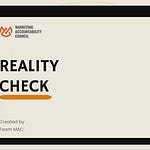This week’s MAC session featured Erez Levin, a former Google insider and current ad quality strategist. With over a decade deep in the trenches of programmatic media, Erez walked us through the systemic rot in how digital advertising is valued and how marketers still reward low-quality media with high-quality dollars. It was a step-by-step breakdown of how the ad industry incentivizes garbage, how measurement systems reward it, and how we’ve all been complicit in letting it happen.
Key Takeaways from the Meeting
1. Advertisers Are Paying Top Dollar for the Worst Inventory
Erez shared findings from a real-world study where participants rated different video ad placements on their ability to drive brand awareness. The results were precise and damning. The lowest-rated format was a small, muted video ad tucked into the corner of a webpage, barely noticeable and completely ignorable. It scored just 1.8 out of 10 on perceived effectiveness.
Yet despite its poor performance, this format now accounts for a significant portion of video ad spend across the industry. Why? Because it meets the bare minimum technical criteria for an impression: it loads, plays, and counts.
The issue isn’t just the existence of low-quality placements; the market prices them as if they’re premium. There’s little to no cost differentiation between these subpar formats and full-screen, sound-on video ads that can engage the viewer.
This failure to distinguish real value from technical compliance has created a warped incentive structure. Platforms and publishers flood the ecosystem with these low-attention units, and advertisers, often unknowingly, keep funding them. The result is a race to the bottom in media quality, disguised by standardized pricing and vanity metrics.
Until advertisers demand valuation that reflects true placement quality, not checkbox metrics, they’ll keep wasting budget on ads no one sees or remembers.
2. Most 'Instream' Video Inventory Isn’t Instream At All
For years, publishers and platforms have exploited a relatively lucrative loophole in the IAB’s video advertising standards. Under the old definition, a video ad could be labeled as “instream” simply by being followed by any video content, regardless of whether the viewer intended to watch the video or whether the sound was on.
This allowed text-based pages (like news articles or recipe sites) to auto-play a muted video ad mid-scroll, slap on the “instream” label, and charge advertisers three times the CPM of standard outstream inventory. All without delivering the viewing context or attention advertisers thought they were paying for.
In reality, this kind of placement offers none of the immersive, lean-in engagement that true instream formats like YouTube or Hulu pre-rolls deliver. It’s a video in name only—technically compliant under outdated rules but fundamentally misleading in function and impact.
The IAB updated its guidance to close this loophole. The new standard specifies that for a video ad to be considered “instream,” the ad must play with sound on, a simple, enforceable rule that restores some baseline of viewer engagement.
But here’s the catch: most platforms and intermediaries haven’t adopted the new standard. As a result, advertisers are still being charged premium rates for placements that don’t meet the new criteria. Billions in ad spend continue flowing into low-quality environments under pretenses, propped up by legacy definitions and inertia.
The consequences are huge:
Massive mispricing of inventory
Distorted performance data across channels
Undue trust in environments that don't deserve it
For advertisers, the message is clear: if your video ads are running on “instream” inventory, you need to verify whether they meet the new standard. Because odds are, they don’t, you're overpaying for the illusion of premium media.
3. The ‘Freeloading Bystander’ Problem Is Real
Originally coined by analyst Kerry Cunningham, the freeloading bystander problem describes a fundamental flaw in how most marketers assign credit to their campaigns: we reward the tactic that happened to be running at the moment of conversion, even if it didn’t cause the outcome.
Attribution models built around last-touch or time-of-conversion logic mistake correlation for causation. A campaign might be active when a customer takes action, but that doesn’t mean it influenced the decision. In many cases, the intent was already there, driven by earlier brand exposure, peer input, or product experience.
This creates a distorted feedback loop. Campaigns that “show up” during buyer action look like top performers on dashboards. Meanwhile, the real work, often long-term, foundational brand building, gets overlooked.
The fallout is strategic misalignment:
Short-term tactics get overfunded
Brand investments get undercut
Marketers prioritize visibility over influence
Cunningham’s framework forces a more complex question: not just what was running when the sale happened, but what drove the desire to buy? Answering that requires better models, longer time horizons, and a shift away from reactive media metrics.
4. Attention Metrics Are a Proxy, Not a Promise
In a market overrun with weak proxies for effectiveness, clicks, viewability, and completion rates, it’s no surprise that attention has become the latest buzzword metric. Agencies, platforms, and vendors are racing to build models and dashboards claiming to measure how much attention an ad receives.
But Erez challenged the industry’s excitement with a critical distinction: most “attention” metrics don’t measure cognitive engagement or brand impact. They’re simply rebranding placement quality—how long the ad was on screen, whether the sound was on, and how prominent the placement was in the user’s field of view.
In other words, attention data often captures the conditions for attention, not attention itself.
This is a useful shift—but only if marketers understand it for what it is. These signals are closer to media hygiene than persuasion. They tell you whether the ad had a fair shot at being seen, not whether it worked. And without proper context, attention scores can easily become another vanity metric—more precise, but still misleading.
The real value of attention data isn’t in comparing one format to another. It’s in helping buyers identify underperforming placements that are priced as if they’re premium. It’s not a creative metric. It’s a media buying optimization tool.
Marketers misusing attention as a shortcut for impact are falling into the same trap we’ve seen before: assuming measurement equals meaning. Attention metrics must be paired with brand outcomes, not sold as stand-alone KPIs to do it right.
Strategic Next Steps for Marketers
1. Audit Your Video Spend Now
Ask how much of your “instream” inventory would qualify under the new sound-on rule.
Demand transparency around where your ads are running.
Push for relative valuation of placements—stop treating all impressions equally.
2. Rethink Your Metrics Hierarchy
Viewability isn’t enough.
Clicks are incomplete.
Attention is not impact unless connected to outcomes.
Build a measurement framework that includes mental availability, brand recall, and long-term effect—not just immediate action.
3. Rebalance Short-Term vs Long-Term Value
Marketers are overweighting the click and underweighting the unseen but cumulative value of quality brand exposure.
“Most ads deliver both short- and long-term value. But marketers are still letting the short-term metrics run the show.” — Erez Levin
4. Prepare for a Market Correction
If the current stock of misclassified video inventory is redefined or removed, supply will shrink. That will create:
A sharp rise in price for truly high-quality placements.
An urgent need for better creative and media planning to justify cost.
A power shift away from remnant media sellers.
5. For SMBs: Focus on Context and Control
Platforms like TikTok and Instagram give more visibility into actual delivery.
Don’t assume “cheap reach” is effective reach.
Every dollar counts more—so placement quality matters even more.
6. For Enterprise: Pressure Your Partners
Ask your media agency how they’re defining instream.
Push for custom valuation models, not off-the-shelf metrics.
Train your teams to distinguish between media cost and media value.
The Bottom Line
This industry is still buying on trust, not evidence, and optimizing for what’s measurable, not what matters. It is still a mistaken presence for impact.
“If you want to get rich in this business, lie to people who want to be lied to. If you want to make a living, tell the truth to people who want to hear it. If you want to be poor, tell the truth to people who want to be lied to.” — Erez Levin
What comes next isn’t more metrics. It’s better judgment. Smarter buying. Sharper creative. And marketers who are finally ready to call the bluff.
You have the information now. Make it count.
👇 Stay In the Loop
If this session gave you the wake-up call your media strategy needed, good. That’s what we do here.
The Marketing Accountability Council (MAC) brings together marketers, strategists, creatives, analysts, and media misfits to challenge broken systems, rethink the status quo, and raise the bar for what this industry should be.
We host weekly live sessions—open, unscripted, and unfiltered—featuring practitioners who don’t just talk theory, but bring receipts. Join us, speak up, or just listen in. No pitch decks. No B.S. Just better marketing.
Watch, Learn, Question — Every Friday
Want more clips like these? Full sessions, sharp insights, and real marketing talk—no fluff, no filters.
👉 Subscribe on YouTube:
youtube.com/@MarketingAccountability
🎙 Join us live every Friday at 3 PM EST
New guests. Real conversations. And a little chaos. Don’t just scroll—show up.
Hit that subscribe button and turn on notifications. You’ll thank yourself later
Follow Erez Levin
If you want sharper, data-backed insights on how ad systems work and how to fix them, connect with Erez.
He’s building the future of ad quality, media accountability, and smarter measurement.
🔗 Follow Erez Levin on LinkedIn
💡 Product strategist, media realist, system reformer.
















